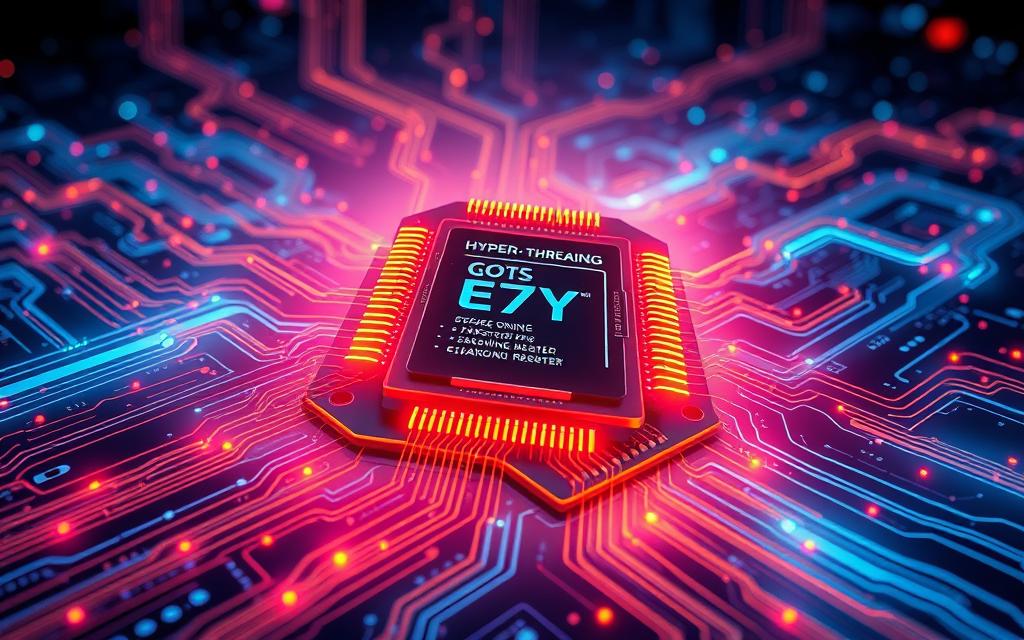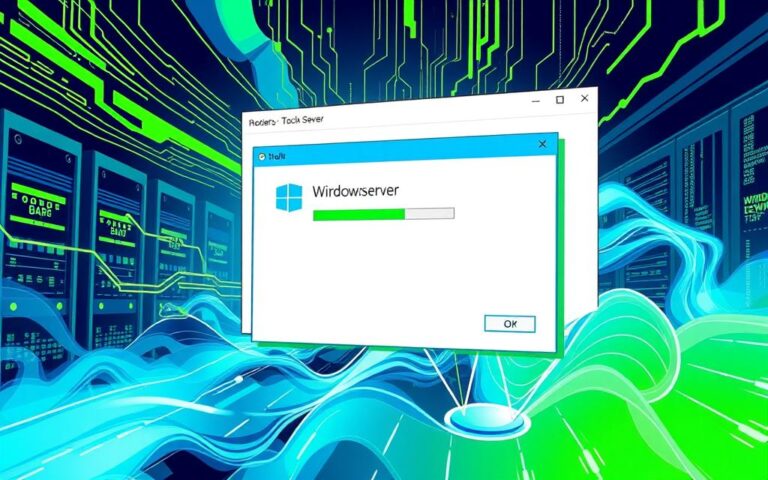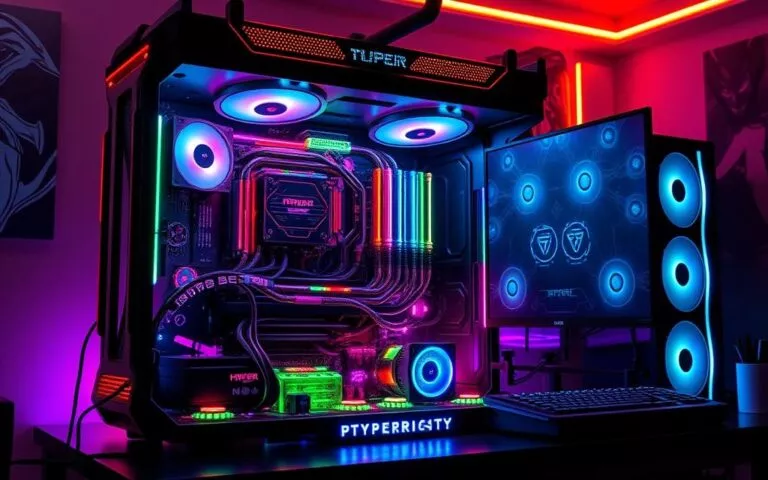How Hyper-Threading Enhances Computer Performance
Hyper-Threading technology makes computers faster, especially for multitasking and heavy apps. Developed by Intel, it lets one processor act like many. It makes CPU use more efficient. This boosts the CPU’s speed and how quickly it responds. We will explore how Hyper-Threading works, its advantages, and its impact on computing.
What is Hyper-Threading?
Hyper-Threading technology comes from Intel. It’s a kind of simultaneous multithreading (SMT) that makes a processor more efficient. With this, each physical core of a processor works like two logical cores. It started on November 14, 2002, with the Pentium-4’s Northwood-B core. It greatly improves how modern computers do more than one thing at a time.
Hyper-threading lets a single core do several tasks at once. It splits each physical core into two threads. This doubles the logical processors that the operating system can use. So, it significantly boosts how well a computer can handle tasks, particularly when using programs that run multiple threads.
When hyper-threading is on, your computer will show more processors in the Device Manager. It shows how it adds virtual cores. Even though having many cores already helps with managing tasks, hyper-threading increases a system’s overall performance.
The Core i7, i9, and Xeon from Intel often use hyper-threading. AMD’s Ryzen 5000 series also has something similar with its simultaneous multithreading. This technology makes it possible for tasks to flow better through the CPU. It does this by using different paths and sets of registers for the threads.
In gaming, hyper-threading can really improve how games play, but only if the games and hardware work well together. However, not all programs benefit the same way from it. The success of hyper-threading depends a lot on what it’s used for and the system it’s on. To understand it better, you can read more about hyper-threading and its various uses.
How Hyper-Threading Works
Learning about Hyper-Threading mechanics reveals the boost in CPU power. Intel introduced this technology on November 14, 2002. It lets a single physical core work as two logical processors. So, each core can manage two CPU threads at once, handling more tasks in every clock cycle.
With Hyper-Threading on, a single core becomes two virtual ones. This makes the CPU work on different tasks at the same time. Thanks to separate setups, Hyper-Threading improves how threads are handled. It makes the CPU use its resources better, cutting down on wasted time.
The system sees these logical processors as two units. This helps it do multiple tasks at once, increasing speed on various jobs. But, even with advanced sharing, cores might fight over limited memory. Even so, the gains usually beat the downsides, making things smoother when doing many tasks.
Today, most computers support Hyper-Threading. Intel’s top processors, like the Core i7, i9, and Xeon, feature it. Turning on Hyper-Threading in BIOS is a smart move for those who want their CPUs to do more, especially with big tasks.
For details on web features and how users can set their preferences, check out the Cookie Policy.
Benefits of Hyper-Threading Technology
Hyper-threading technology brings remarkable advantages of hyper-threading. It greatly improves computer performance. By running two threads at once, it acts like two CPUs in one. This boosts multitasking, letting users work on many apps more smoothly.
Intel Corporation developed hyper-threading. It’s in many Pentium 4 and all Intel Xeon processors. This technology greatly helps CPU resource utilisation. It can increase performance by 30% in single-socket systems and by 15% in dual-socket systems. Each core can do two tasks at the same time. This makes things run better, especially with tough apps or games.
Hyper-threading doesn’t double a core’s power, but it maximises efficiency. It lets a core work fully even when busy. Some software might not use hyper-threading well, which can lessen its effect. Overall, it makes switching tasks smoother. This boosts managing tasks and running background processes, leading to great multitasking experience.
Hyper-threading has its pros, but it can make things hotter. More work means you need good cooling to stop damage. With the right management, hyper-threading uses CPU resources well. It changes how apps work, especially in demanding situations.
| Feature | Single-Socket System | Dual-Socket System |
|---|---|---|
| Performance Improvement | Up to 30% | Up to 15% |
| Core Functionality | Simultaneous thread execution | Enhanced resource sharing |
| Multitasking Efficiency | Improved | Effective |
| Heat Generation | Increased | Increased |
| Cooling Requirements | Necessary | Necessary |
Hyper Threading Computer Performance in Gaming
Hyper-Threading technology boosts gaming, especially in games made for multi-threading. Multi-threaded optimisation in games means they can handle many tasks at once, more smoothly. This leads to better gameplay and experiences in complex scenes, as Hyper-Threading uses extra logical cores to improve frame rates and game responsiveness.
Optimised Games and Multi-threading
Many current games take advantage of Hyper-Threading technology. This tech helps games work better across several threads. This improves game speed and reduces delays. Some top games include:
- Battlefield V – Uses multi-threading for large battlefields and many actions at the same time.
- Microsoft Flight Simulator – Benefits from Hyper-Threading to show detailed landscapes and multiple planes.
- The Witcher 3: Wild Hunt – Uses extra processing power for better AI and environment interactions.
However, game performance with Hyper-Threading can differ a lot. This often depends on the game engine and how it uses processing resources.
Potential Performance Limitations
Not every game performs better with Hyper-Threading. Older games or those made for single-threaded processing may not see much benefit, potentially leading to performance issues. Players might face:
- Increased resource competition – More virtual cores don’t always mean better performance and could cause resource issues.
- Gaming limitations – Games with a set number of processing threads might not fully use Hyper-Threading.
- Hyper-threading drawbacks – Sometimes, turning off Hyper-Threading improves performance in older or simpler games.

Figuring out Hyper-Threading’s effect on games requires testing them one by one. Sometimes, turning it off can surprisingly help, especially on systems running single-threaded software. It’s a good idea to check your gaming setup to get the most from your system.
Enhancing Performance for Programming and Software Development
Hyper-threading transforms how developers work on projects. It lets a single processor act like many. This way, coders can do several tasks at once. Hyper-threading is a game-changer when compiling code or running simulations. It boosts software development efficiency by managing multiple instructions together.
Using hyper-threading noticeably boosts coding speed because it uses CPU resources well. Developers handling many tasks at once find their work speeds up. This not only makes jobs quicker but also makes them more productive.
Imagine software tasks split among many threads. Using hyper-threading well can cut down task time dramatically. It makes processes much faster and shows how valuable hyper-threading is.
| Programming Task | Time without Hyper-Threading | Time with Hyper-Threading |
|---|---|---|
| Code Compilation | 15 seconds | 5 seconds |
| Running Simulations | 30 seconds | 10 seconds |
| Data Analysis | 20 seconds | 7 seconds |
In conclusion, hyper-threading saves lots of time for programmers. It helps developers work better and faster. By using this technology, software experts see big improvements in efficiency and speed.
Hyper Threading Computer and Video Editing Efficiency
In video editing, being efficient can make a huge difference for creators. Hyper-Threading technology greatly improves video editing by making processors work better on rendering tasks. This means videos can be made faster and more effectively, especially in demanding projects.
Parallel Processing in Video Rendering
Hyper-Threading lets processors split each core into two logical ones. This helps with parallel processing during video rendering. While one part of the video gets processed, another part can be worked on at the same time.
This approach cuts down rendering time significantly. It’s great for editors who have tight deadlines. Hyper-Threading makes the CPU work harder, increasing how much work gets done.
Effects on Processing Speed
The speed at which video editing software works with Hyper-Threading is amazing. It uses logical cores to speed up rendering and processing. Large projects can be finished quicker, reducing wait times for renders.
This lets editors focus more on making the content better. They spend less time waiting and more on creating quality videos.
Compatibility and Support for Hyper-Threading
It’s crucial to understand hyper-threading compatibility to boost computing power. Not every processor can handle hyper-threading. This is mainly an Intel CPU feature. It’s important to check your processor’s support with official documents from the maker.
The operating system plays a big role in getting the most from hyper-threading. It must support simultaneous multithreading (SMP) for better performance. Windows and Linux are suited for this technology.
Using tools like CPUID lets users see if hyper-threading is possible on their processors. This applies to x86 processors, starting with the 486 series. Another way is using dmidecode on Linux to check SMBIOS info. This gives clear details about the processor.
To use hyper-threading well, some software might need tweaks. Understanding your CPU’s limits helps set it up correctly. This ensures the best computing experience.
| Aspect | Details |
|---|---|
| Processor Types | Intel CPUs are primarily known for hyper-threading capabilities. |
| Identification Tools | CPUID for general support checking; dmidecode for SMBIOS information. |
| Operating Systems | Windows, Linux (with SMP support) to utilise hyper-threading. |
| Custom Configurations | Some applications may require specific settings for optimal performance. |
| Importance of Documentation | Refer to manufacturer guidelines for processor support and compatibility details. |
Conclusion
Hyper-threading technology brings big benefits that boost computer performance a lot. It makes one physical processor core act like two logical ones. This means computers can do many tasks at once, smoothly and better.
This helps a lot in gaming, coding, and editing videos. You can do more things at the same time without slowing down. However, some situations might not get as much benefit from hyper-threading. It’s important to know when it works best for your computer needs.
Today’s operating systems and tools work well with hyper-threading. This makes sure that CPUs are used to their max ability. Whether it’s for big servers or your home PC, using hyper-threading can make a huge difference. It makes everything run faster and smoother.
FAQ
What is Hyper-Threading Technology?
Intel developed Hyper-Threading. It lets a single processor act as several virtual ones. This boosts multitasking and CPU performance a lot.
How does Hyper-Threading improve multitasking?
Hyper-Threading lets a CPU core handle many tasks by seeing them as two logical processors. This use maximises CPU resources, boosting performance while multitasking.
What are the benefits of using Hyper-Threading?
Benefits include better multitasking, higher system performance, and improved resource use. It also speeds up demanding tasks like programming, gaming, and video editing.
Is Hyper-Threading suitable for all games?
Not every game gains from Hyper-Threading. Single-threaded games might not run as well, but multi-threaded games get a performance boost.
How does Hyper-Threading assist in programming efficiency?
It makes programming faster by better using the CPU. Multiple threads can run at once, cutting down on time needed for compiling code and doing simulations.
What impact does Hyper-Threading have on video editing performance?
It speeds up video editing by doing several tasks at the same time. This means faster rendering and a smoother workflow for creators.
Does every processor support Hyper-Threading?
Not every Intel CPU has Hyper-Threading. It depends on the model. Check your processor specs to see if it’s supported.















